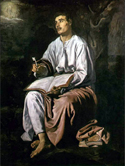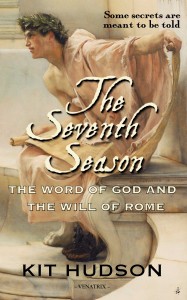There is no record of Emmanuel of Samaria in any other text apart from the Aksum scrolls. All we know of him is what he wrote of himself.

St John, by Velazquez
He tells us that his father was a mapmaker and that he is from Samaria (the name of both a city and a province in ancient Judaea – it is not clear if he is from the city or the surrounding countryside). In a large part due to the parable of the good Samaritan, there is a perception that Samarians were not Jews, even though it is just a day or so’s journey from Jerusalem. It certainly seems from the text that Johanan (Emmanuel was an honorific title given to him by Pope Linus when he visited Rome) was raised in a Jewish family. He is certainly familiar with Jewish scripture, though of course he is at pains to express his agnosticism.
As a child, he travelled with his father who supplied maps to universities, suggesting he was highly skilled at his craft. In The Seventh Season, he mentions having a younger brother and also says that he believes his father has died. This lack of certainty was extremely common in the ancient world – if people did not return from a journey there was often no way of finding out what had happened to them.
A gifted linguist, Johanan found work with the magistrate’s office in Jerusalem which is where he met Andreas. Following the events of The Seventh Season, we know that Johanan visited Rome and spent time in Patmos, where it seems he was rescued from prison by members of Delos who asked him to write his memories of his adventures with Dido.
The Patmos connection has led to a lot of speculation that Johanan is also the John who wrote the Book of Revelation. There would appear to be some textual reasons for this – and I am nothing close to an expert on this matter – and some of Kit’s footnotes suggest to me that he thinks this may have been the case.
John receiving his revelation has been a popular subject for artists throughout the past two millennia, including this image from Velazquez which I like because the figure even has a flattened nose, which Johanan describes himself having in the text!


